Indice
Thermal Detectors
Detection Principles
A thermal detector in principle is a very sensitive calorimeter which measures the energy deposited by a single interacting particle through the corresponding temperature rise. For this mechanism to be really effective the detector must have a very small heat capacity: this is accomplished by using suitable materials (dielectrics, superconductors below the phase transition, …) and by running the detector at low temperatures (usualluy below 100 mK) in a refrigerator (we use dilution refrigerators).
A thermal detector is made up by three main components:
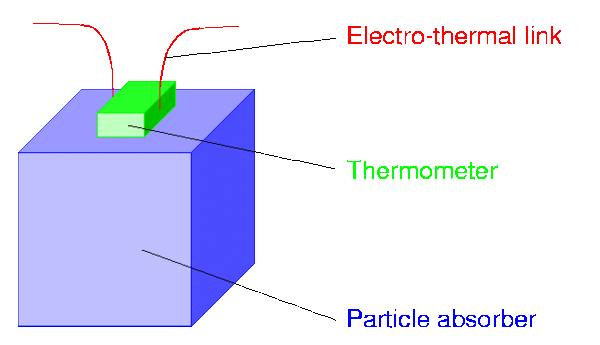
- The particle absorber is the sensitive mass of the device. Here the particles deposit their energy. The material can be choosen quite freely but it must have a low heat capacity and it must stand the cooling in vacuum. The absorber can contain any interesting unstable isotope so that it is possible to perfom many interesting experiments like neutrinoless double beta decay searches, dark matter (WIMP) searches or beta decay spectroscopy to measure the neutrino mass. The absorber mass can range from few micrograms to almost one kilogram.
- The thermometer in a sense is the most important part of the thermal detector since its purpose is to measure the temperature rise induced by the particle interaction. Among the many type of thermometers which have been developed for the thermal detectors we are using doped semiconductor thermistors because their ease of use and the reproducibility with which they can be produced in large quantity.
- The thermal link to the heat sink which usually provide also the electrical link.
Microcalorimeters are a class of thermal detector caracterized by a very small size (less than 1 milligram) and in general by a high energy resolution (few tens of eVs for soft X-rays). The drawing below is a sketch of how they are made.
In a microcalorimeter the thermal and electrical links are provided by Al bonding wires and the small absorber is glued below the thermistor. To achieve the necessary sensitivity the electronic front-end is placed very close to the detector: this reduce the input stray capacitances and therefore both the microphonic noise and signal RC integration.
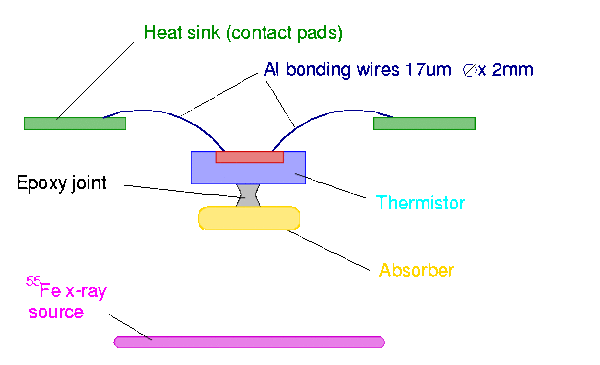
Thermistors
For our high energy resolution microcalorimeters we use to type of thermistors: silicon implanted and NTD germanium thermistors. Both are doped to such a level that below 1K the electrical conduction regime is the Variable Range Hopping characterized by a resistivity steeply temperature dependent.
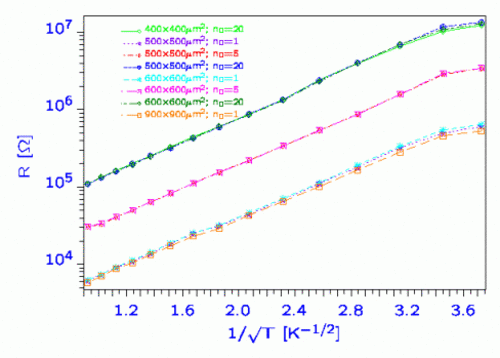
Silicon implanted thermistors
Silicon implanted thermistors have been developed in collaboration with IRST in Trento, Italy. They are made by multiple ion implantation on silicon wafers using the planar technology [10]. Their major advantages with respect other sensors are the reproducibility and the possibility of large scale productions. Moreover we are implementing the micromachining to built fully integrated thermistors.
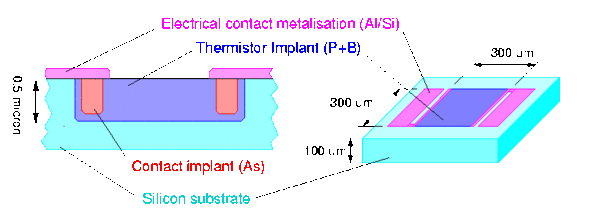
Neutron transmutation doped (NTD) germanium thermistors
NTD germanium thermistors are made by LBL in California, USA. They are made by exposing a ultrapure germanium single crystal to a nuclear reactor neutron flux. They are characterized by an extreme reproducibility even if they are in part made by hands.
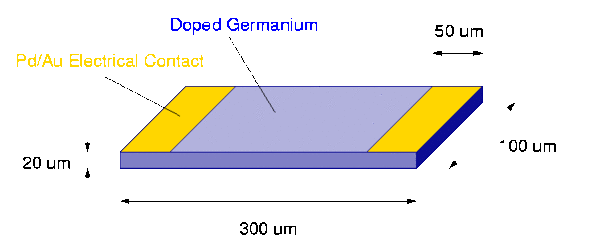
Additional material
- A. Nucciotti, "Application of cryogenic detectors in subnuclear and astroparticle physics" (Presented at 11th International Workshop on Low Temperature Detectors (LTD-11) Takeda Hall, University of Tokyo, JAPAN, August 1st, 2005